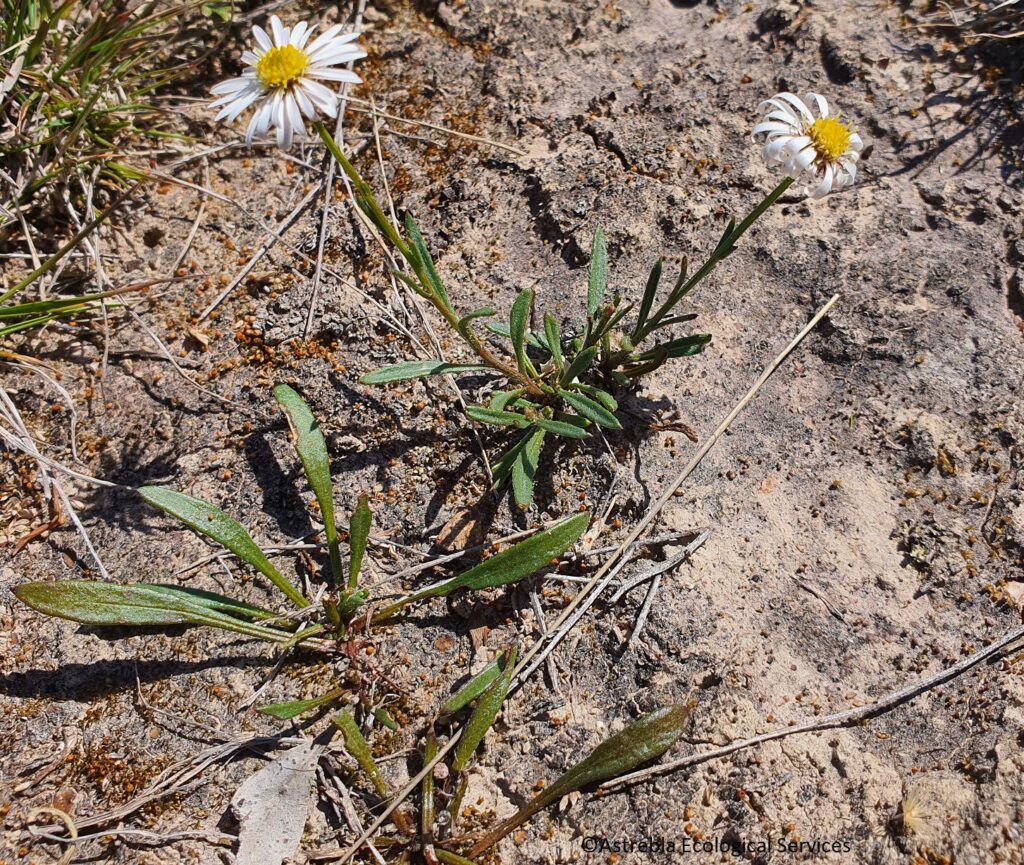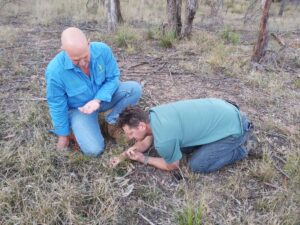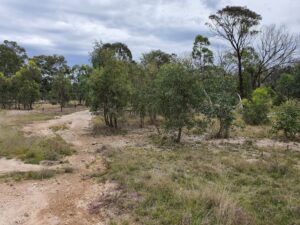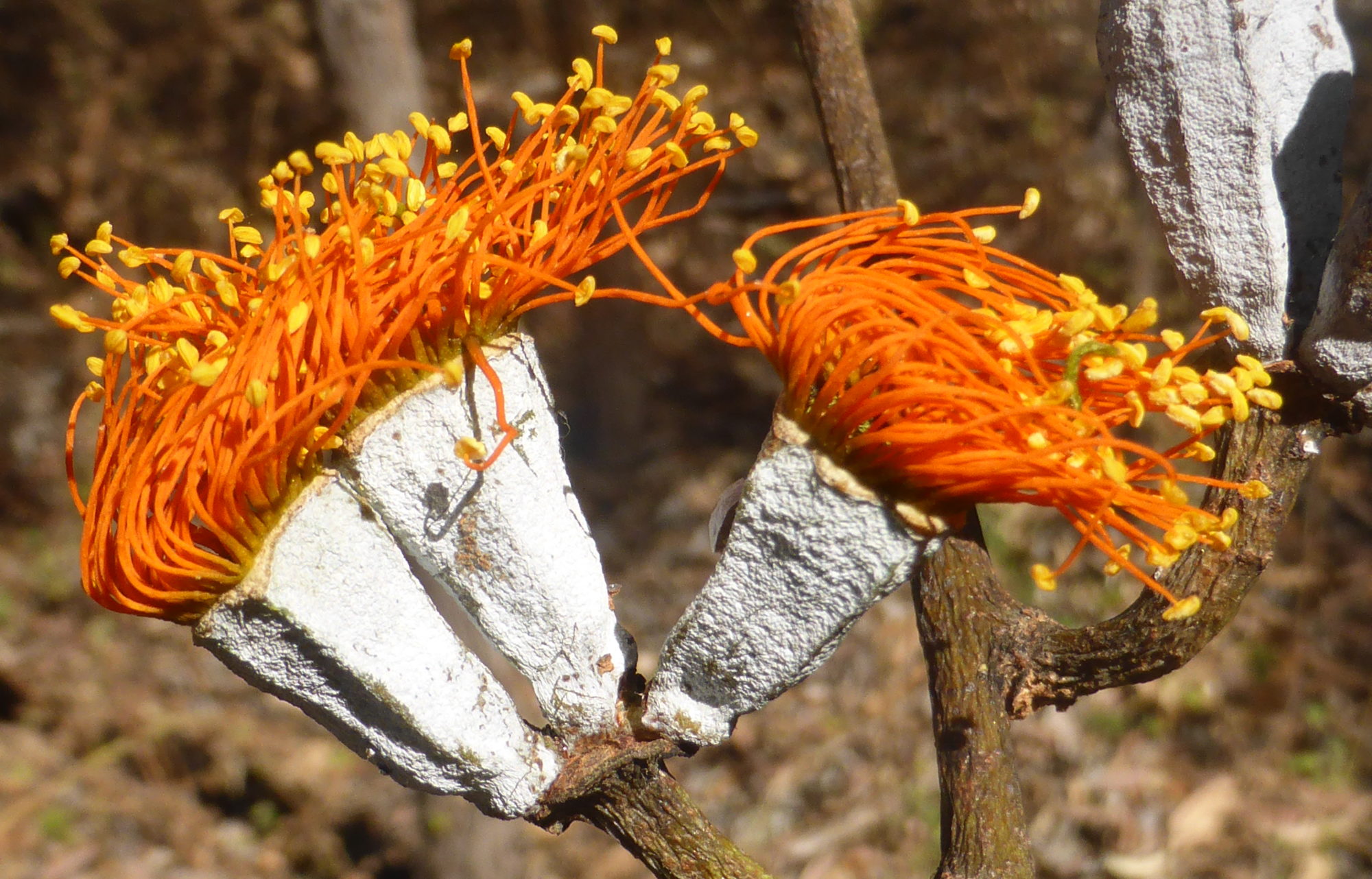In early October 2021, I undertook four weeks of protected plant surveys in the Karara-Cement Mills-Gore-Goldfields area, immediately to the south of Durakai State Forest, approximately 40 km west of Warwick in south-east Queensland. The surveys were undertaken in company with Carly Sugars and Peter Moonie of Red Ash Consulting, and George Brady from GHD (Astrebla was contracted to GHD for this work). In total we walked over 500 km of meandering transects during these surveys, in generally beautiful south-east Queensland spring weather! It was a complete joy!
One of the species being targeted was Calotis glabrescens C.T. White (white burr-daisy), a small daisy listed as critically endangered under the Queensland Nature Conservation Act 1992 (but not listed under the EPBC Act).

Presumed extinct
Until recently, this species was listed under the NC Act as presumed extinct, as there were only two records. The species had been described from one collection by Cyril T. White in 1946 (the Queensland government botanist who succeeded Bailey). White had collected the plant in late September from near Bybera, in what is now Whetstone State Forest, noting it was ‘moderately common in open forest land’. The next collection was in November 1997 by the Queensland Herbarium, who noted it was a ‘low herb to 10 cm tall with pinkish inflorescences, uncommon, scattered at site’. This collection came from approx. 18 km south-west of Leyburn.
The species was not collected again after 1997 until 2 records in 2020 (strangely, these have disappeared from AVH since November 2021), from Durikai State Forest and another site south-west of Leyburn. There are no records from outside Qld, although the excellent ‘Plants of Western NSW’ book (Cunningham, Mulham, Milthorpe & Leigh, 1992) claims there is one record from the Bourke district (Plant Net has no entry for this species, so the source of this record is unclear – it would be a substantial range extension if confirmed).
Our survey found a small population of these plants approximately 7 km south-west of Karara, just north of the Cunningham Highway (thanks to eagle-eyed Peter Moonie for finding them in the first few steps of what would be 500 km of transects!!).
There is little recorded on this species, and no photographs are publicly available, so this blog seeks to provide sufficient information to assist in the planning of targeted surveys for Calotis glabrescens, and in its field identification.

Habitat
Collection records for the species associate it with open forest and semi-cleared areas containing species such as Eucalyptus moluccana, E. sideroxylon, E. viridis and the wattles Acacia montana and A. ixiophylla. The 1997 collection notes state it was found in ‘very tall woodland’ – I have visited the site of this record, and found that, using the current method for classifying vegetation communities used by the Qld Herbarium (based on Specht’s structural forms), it is not even close to ‘tall’, the canopy having a median height of approx. 15-18 m.
The 1997 collection notes also associate it with ‘traprock’ – this is a type of metamorphic rock known from the Warwick area (as with C. glabrescens, there is little to no information publicly available about this rock type).

Our survey found 15 plants growing on an undulating plain beside a dirt track, on a hard-setting pale clay loam, on the edge of a large clearing (but in the clearing, not in the adjacent woodland). Adjacent woodland was co-dominated by E. moluccana and E. dealbata, and was relatively low (median height of 10-15 m). The parent rock was metamorphic and the pre-clear regional ecosystem was RE 13.11.8 (Eucalyptus melliodora and/or Eucalyptus microcarpa/ E. moluccana woodland on rolling hills, depressions and lower slopes around drainage lines, on metamorphics) (Qld Herbarium, 2021).

Species identification notes
Calotis glabrescens is a small daisy growing 15-20 cm tall. It superficially resembles a number of other Calotis spp., mostly C. cuneata and C. scapigera. However, it should be relatively straightfoward to field-identify it, using the Calotis key in Keybase prepared by Ailsa Holland. There is also a useful illustration of the achenes of a number of Calotis spp. including C. glabrescens on p. 654 of Plants of Western NSW (Cunningham et al., 1992)
The major identification features (as outlined by Ailsa Holland) are:
- The plant is relatively gracile – generally 15 cm tall but may extend to 20 cm, with cauline leaves and lacking a distinct basal rosette. It does not have stolons.
- Flower heads are distinctly pedunculate, with peduncles >1cm long, and ray florets >2.5 mm long.
- The rays are white (may be pinkish) and disc florets are yellow (see pic above).
- Achenes lack scales (wings) – achene scales should be obvious, they are flaps of tissue that extend upwards from the crown of the achene.
- C. glabrescens achenes have 2-9 longer, rigid primary awns arranged around the outside edge of the achene crown – these awns have retrose (ie downward pointing), translucent barbs (see pics of achenes below).
- In addition to the primary awns, there are several secondary awns – these lack the barbs of the longer primary awns.
- In addition, the awns of C. glabrescens are NOT joined with each other at the base.
- The achenes are generally as long as they are wide i.e. the horizontal and vertical axes at their longest points are approx. the same length (don’t include the spread of the awns in this measurement).
Also, look for leaves that are generally entire, but that sometimes have a single marginal tooth.


Survey timing
Flowers and particularly mature achenes are likely to be essential to identify this species with any certainty. Our survey was conducted in October 2021. Other collection records are from 20 September through to mid-November.
Survey challenges
This species is difficult to survey for because it is physically small and may be dwarfed by the grasses and other herbs it occurs in association with. In addition, it may be present with other superficially similar Calotis spp., which may be abundant and so may desensitise those searching, who are looking for small Calotis individuals with entire leaves and flowers with white ray florets and yellow discs. Apparently suitable habitat is also common within its geographic range – therefore, there may be large areas to cover.
Therefore, it may be easy to dismiss C. glabrescens as C. cuneata or C. scapigera (which both have stolons and serrated leaves in a basal rosette). There is only one way to survey properly for this species – slowly and carefully.
References
Australasian Virtual Herbarium (AVH), 2022, The Australasian Virtual Herbarium. Council of the Heads of Australasian Herbaria. https://avh.chah.org.au/.
Cunningham, G.M., Mulham, W.E., Milthorpe P.L. and Leigh, J.H, 1992, Plants of Western New South Wales, CSIRO Publishing, Melbourne.
Queensland Herbarium, 2021, Regional Ecosystem Description Database (REDD), version 12.0, Department of Environment and Science, Brisbane.
White, C.T., 1946, Contributions to the Queensland Flora, No. 9. Proceedings of the Royal Society of Queensland 57: 30.
